
Journal of Mathematical Physics Analysis Geometry
Scope & Guideline
Bridging the Gap Between Theory and Application
Introduction
Aims and Scopes
- Mathematical Analysis and Differential Equations:
The journal emphasizes the study of various types of differential equations, including elliptic, parabolic, and fractional types, often focusing on their solvability, stability, and qualitative behavior. - Geometry and Topology:
Research on geometric structures, including Ricci solitons, warped products, and the interplay between geometry and analysis, is a core aspect of the journal's offerings. - Functional Analysis and Operator Theory:
The journal covers advancements in functional analysis, particularly in the context of operator theory, spectral analysis, and the study of frames and bases in Hilbert spaces. - Mathematical Physics:
A significant portion of the journal is dedicated to the intersection of mathematics and physics, exploring topics such as quantum mechanics, statistical mechanics, and the mathematical foundations of physical theories. - Control Theory and Variational Methods:
The journal publishes works related to optimal control problems, variational inequalities, and associated mathematical techniques, reflecting a strong interest in applied mathematics.
Trending and Emerging
- Fractional Calculus and Differential Equations:
There is a noticeable increase in research related to fractional derivatives and their applications to various types of differential equations, indicating a growing interest in non-local phenomena. - Geometric Analysis:
Recent publications highlight a surge in geometric analysis, particularly studies involving Ricci solitons and curvature properties, which are gaining traction in both mathematics and theoretical physics. - Stochastic Processes and Random Matrices:
The exploration of stochastic processes, particularly in the context of random matrices and their statistical properties, has become more prominent, reflecting broader trends in mathematical physics. - Control Theory Applications:
An increasing number of papers are focused on control theory, particularly regarding its application to partial differential equations and variational problems, indicating a shift towards applied mathematics. - Numerical Methods and Computational Geometry:
The journal is also seeing a rise in the publication of works involving numerical methods and computational approaches to geometric problems, which are essential for practical applications in physics.
Declining or Waning
- Classical Geometry:
Interest in classical geometric topics, such as traditional studies of curves and surfaces, seems to be decreasing, with fewer papers addressing these subjects directly. - Elementary Number Theory:
Although foundational, research in elementary number theory appears less frequently in recent publications, possibly overshadowed by more complex mathematical frameworks. - Static Solutions to Differential Equations:
There seems to be a waning emphasis on the exploration of static or equilibrium solutions of differential equations, as the journal shifts towards dynamic and evolutionary problems.
Similar Journals
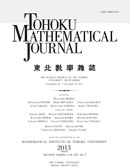
TOHOKU MATHEMATICAL JOURNAL
Connecting Mathematicians Through Groundbreaking InsightsTOHOKU MATHEMATICAL JOURNAL, published by TOHOKU UNIVERSITY, is a distinguished academic journal committed to the advancement of mathematical research. Established in 1949, the journal has sustained a long-standing tradition of disseminating high-quality, peer-reviewed articles that contribute significantly to various branches of mathematics. With its scope encompassing a broad range of topics within the field, TOHOKU MATHEMATICAL JOURNAL aims to foster intellectual exchange and innovation among mathematicians worldwide. Though currently not an open-access publication, it is indexed in Scopus, holding a respectable Q2 ranking in the miscellaneous mathematics category as of 2023, which signifies its relevance and influence in the academic community. Researchers, professionals, and students alike will find valuable insights and contemporary developments that reflect the journal's dedication to excellence in mathematical scholarship.

Symmetry Integrability and Geometry-Methods and Applications
Bridging Theory and Application in Mathematical SciencesSymmetry Integrability and Geometry-Methods and Applications is a prominent open-access journal published by the NATIONAL ACADEMY OF SCIENCES OF UKRAINE, INSTITUTE OF MATHEMATICS, dedicated to advancing research in the fields of Analysis, Geometry and Topology, and Mathematical Physics. Since its inception in 2005, the journal has provided an esteemed platform for scholars from around the globe to share their innovative findings and methodologies, contributing to our understanding of complex mathematical concepts. With an impressive Q2 ranking in all three mathematical categories as per the 2023 Scopus rankings, the journal positions itself as a key resource for researchers seeking high-quality, peer-reviewed content. As a fully open-access publication, it ensures that research is readily available to a wide audience, fostering collaboration and knowledge exchange in the mathematical sciences.
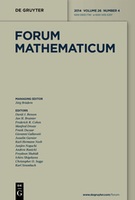
FORUM MATHEMATICUM
Exploring the Depths of Mathematical InnovationFORUM MATHEMATICUM, published by WALTER DE GRUYTER GMBH, is a distinguished academic journal based in Germany, known for its significant contributions to the field of mathematics. With an ISSN of 0933-7741 and an E-ISSN of 1435-5337, the journal features comprehensive studies ranging from applied mathematics to diverse mathematical disciplines. Having maintained a commendable presence since 1989, FORUM MATHEMATICUM has achieved notable classification rankings, including Q2 in Applied Mathematics and Q1 in miscellaneous Mathematics as of 2023. Additionally, it holds a Scopus rank within the top 60th percentile in General Mathematics, making it a prominent platform for researchers and professionals seeking rigorous analysis and innovative methodologies in mathematics. While the journal does not currently offer open access, its rich content is pivotal for advancing mathematical theory and applications, appealing to students and seasoned academics alike.

COLLOQUIUM MATHEMATICUM
Engaging minds with groundbreaking mathematical concepts.COLLOQUIUM MATHEMATICUM, published by ARS POLONA-RUCH, serves as an essential platform for the dissemination of innovative research in the field of mathematics. With an ISSN of 0010-1354 and a dedicated E-ISSN of 1730-6302, this journal plays a crucial role in advancing mathematical knowledge and fostering collaboration within the academic community. Although it is categorized in the Q3 quartile for miscellaneous mathematics, its content consistently attracts a diverse readership, reflecting a wide array of mathematical disciplines. Spanning publication years from 2001 to 2009 and resuming from 2011 to the present, *COLLOQUIUM MATHEMATICUM* offers researchers, professionals, and students the unique opportunity to engage with groundbreaking concepts and methodologies. With its home base in Warsaw, Poland, this journal not only contributes to the regional mathematical landscape but also impacts the broader global community. While currently not adopting an open access model, the journal remains committed to quality research, evidenced by its Scopus ranking within the general mathematics category. Engage with *COLLOQUIUM MATHEMATICUM* to be at the forefront of mathematical exploration.

JOURNAL OF THE EUROPEAN MATHEMATICAL SOCIETY
Pioneering Open Access in MathematicsThe JOURNAL OF THE EUROPEAN MATHEMATICAL SOCIETY, published by the EUROPEAN MATHEMATICAL SOCIETY (EMS), stands as a premier platform in the field of mathematics, known for its rigorous editorial standards and impactful contributions to both applied and theoretical aspects of the discipline. With a commendable Q1 ranking in both Applied Mathematics and Miscellaneous Mathematics categories, alongside a Scopus rank of 32 out of 399 in General Mathematics, this journal has established itself as a crucial resource for researchers and professionals. Since achieving Open Access status in 2021, it has expanded its reach, making cutting-edge research more accessible to a global audience. With a publication horizon extending from 2002 to 2024 and a dedicated focus on high-quality mathematical scholarship, the journal continues to foster innovation and collaboration within the mathematical community.
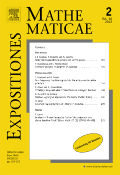
EXPOSITIONES MATHEMATICAE
Cultivating Knowledge in the Heart of Mathematical InquiryEXPOSITIONES MATHEMATICAE, published by Elsevier GmbH, stands as a significant journal in the realm of mathematics, catering primarily to researchers, professionals, and students. With an ISSN of 0723-0869 and an E-ISSN of 1878-0792, this journal has made its mark in the academic community, boasting a Q2 classification in the miscellaneous mathematics category for 2023, illustrating its prominence within its field. The journal addresses a diverse scope of mathematical topics, encouraging the publication of original research and innovative theories while maintaining rigorous academic standards. As it converges from 2004 to 2024, EXPOSITIONES MATHEMATICAE continues to be an essential resource for advancing mathematical knowledge and fostering scholarly communication, despite being a non-open-access publication. Its location in Munich, Germany further anchors it within a rich intellectual tradition, providing accessibility for the mathematical community worldwide.
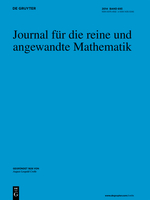
JOURNAL FUR DIE REINE UND ANGEWANDTE MATHEMATIK
Elevating Mathematical Research to New HeightsJOURNAL FUR DIE REINE UND ANGEWANDTE MATHEMATIK is a prestigious publication in the field of mathematics, established in 1826 and proudly published by WALTER DE GRUYTER GMBH, a respected name in academic publishing. Renowned for its rigorous peer-review process, this journal focuses on both pure and applied mathematics, making significant contributions to various mathematical domains. With an impressive impact factor positioning it in the Q1 quartile for both applied mathematics and miscellaneous mathematics categories, the journal ranks 83rd out of 399 in General Mathematics and 282nd out of 635 in Applied Mathematics according to Scopus. The journal does not currently offer open access options but is widely available through institutional subscriptions. Its rich history and ongoing commitment to excellence position the JOURNAL FUR DIE REINE UND ANGEWANDTE MATHEMATIK as an essential resource for researchers, professionals, and students aiming to stay abreast of the latest developments in mathematical theory and practice.
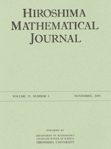
Hiroshima Mathematical Journal
Unveiling the Beauty of Numbers and GeometryThe Hiroshima Mathematical Journal, published by Hiroshima University, Graduate School of Science, serves as a prominent platform for disseminating high-quality research in the field of mathematics. Established in 1959, the journal has been an integral part of the mathematical community, focusing on areas such as Algebra, Number Theory, Analysis, and Geometry and Topology. Although currently classified in Q4 quartile rankings within its categories, the journal is committed to advancing mathematical knowledge and fostering scholarly dialogue. Its accessibility, combined with its long-standing history, makes it an essential resource for researchers, professionals, and students dedicated to exploring and enhancing the mathematical sciences. For those interested in contributing or accessing cutting-edge research, the Hiroshima Mathematical Journal continues to uphold its mission of excellence in mathematical scholarship.
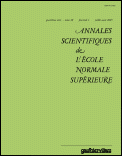
ANNALES SCIENTIFIQUES DE L ECOLE NORMALE SUPERIEURE
Fostering Collaboration in Mathematical ExplorationANNALES SCIENTIFIQUES DE L ECOLE NORMALE SUPERIEURE is a distinguished journal published by the Société Mathématique de France, dedicated to advancing the field of mathematics through high-quality research articles. With a robust impact factor and categorized as Q1 in Mathematics (Miscellaneous) as of 2023, this journal ranks in the top 16% of mathematics publications, showcasing its importance and influence in the discipline. Available in both print (ISSN: 0012-9593) and electronic formats (E-ISSN: 1873-2151), ANNALES SCIENTIFIQUES serves as a central hub for innovative mathematical theories and methodologies, appealing to a diverse audience of researchers, professionals, and students alike. The journal publishes research that spans various domains within mathematics, fostering a collaborative environment for idea exchange. As it converges from 1997 to 2024, it continues to shape the mathematical landscape, providing essential insights and developments within the global academic community. Located in Paris, France, the journal invites contributions that push boundaries and advance the understanding of complex mathematical concepts.
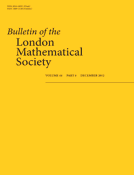
BULLETIN OF THE LONDON MATHEMATICAL SOCIETY
Exploring Innovative Research in MathematicsThe BULLETIN OF THE LONDON MATHEMATICAL SOCIETY, published by Wiley, is a distinguished journal that serves as a vital resource in the field of mathematics. With its ISSN 0024-6093 and E-ISSN 1469-2120, this journal has consistently provided a platform for innovative research and scholarly discourse since its inception in 1969. Recognized for its quality, it currently holds an impressive Q1 ranking in the mathematics category, a testament to its significance in disseminating influential findings and trends in the mathematical sciences. Researchers and practitioners can rely on the BULLETIN for its comprehensive coverage of both theoretical and applied mathematics, which caters to a diverse audience ranging from professionals to students alike. Though it does not currently offer Open Access options, its articles can be accessed through institutional subscriptions, ensuring that significant works reach the academic community effectively. With contributions that span over five decades, the journal continues to shape mathematical research and inspire future advancements in the discipline.